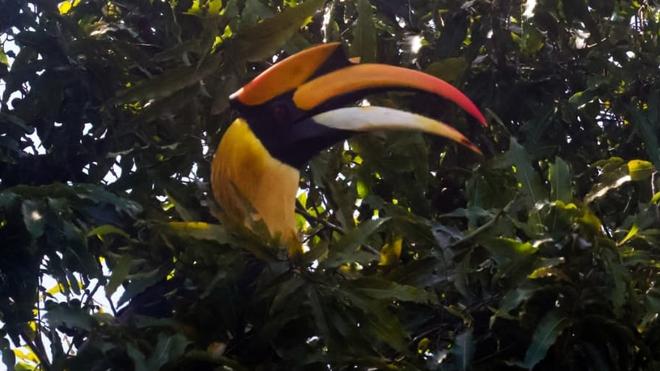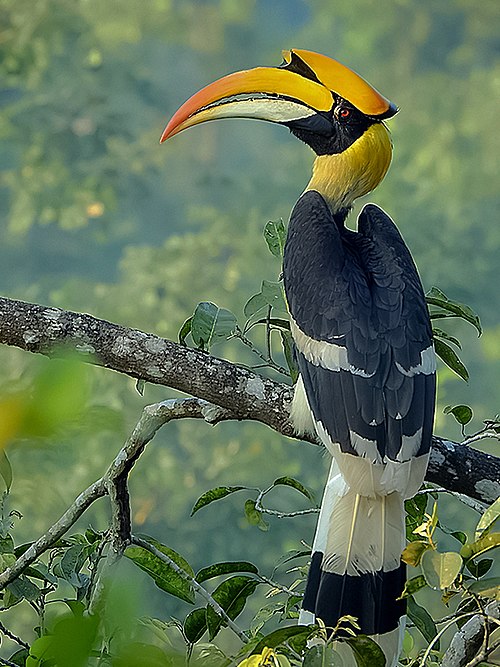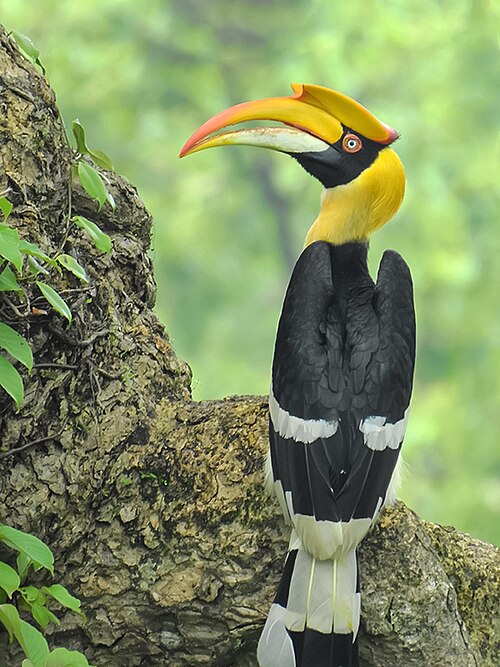Majestic Great Hornbill makes a rare coastal appearance in Kodungallur
In an exceptional event for local ornithologists, a Great Hornbill (Buceros bicornis) was recently sighted in the coastal town of Kodungallur, Kerala. The appearance of this majestic bird, far from its typical habitat, has generated considerable excitement and discussion among wildlife enthusiasts and conservation circles.
The Great Hornbill, the state bird of Kerala, is primarily a resident of dense evergreen and moist deciduous forests, such as those found in the Western Ghats. Its presence in a populated, coastal landscape is highly unusual and considered a significant ornithological record for the region.
Experts speculate that such rare urban sightings could be attributed to several factors, including habitat fragmentation or a search for new food sources, which may compel the birds to venture beyond their traditional territories.
This sighting serves as a valuable data point for researchers studying avian distribution and the impact of environmental changes on wildlife. The event underscores the importance of continued conservation efforts to protect the natural corridors that are vital for the survival of such magnificent species.
Majestic Great Hornbill makes a rare coastal appearance in Kodungallur
The Great Hornbill, usually found in forested and hilly areas, made a rare and notable appearance near the sandy coastal belt between Kodungallur and Kaipamangalam in Kerala, just 200 metres from the beach[3][5][6]. This event was confirmed and documented by researchers, who observed the bird feeding on a large false asoka tree, marking the first-ever recorded sighting of a Great Hornbill at sea level in Kerala[3][5].
Why This Sighting Is Unusual
The Great Hornbill is Kerala’s state bird and is typically restricted to the dense forests of the Western Ghats and similar inland habitats, rarely venturing to coastal regions[3][10]. Previous such appearances have only been in lateritic hillock areas near the coast, not on the actual sandy shoreline[3]. The bird’s presence so far from its normal range might indicate shifts in habitat usage, changes in population dynamics, or even responses to climatic changes[3]. Researchers suggested the following possible reasons:
- Increased population and ongoing conservation efforts may push some hornbills to explore new areas during the non-nesting season[3].
- Hornbills may be adapting to increased human interaction and becoming less wary[3].
- Early seasonal rains, unique weather patterns, or greater vegetation growth this year could contribute to these movements[3].
Details from the Sightings
The hornbill was observed by a research team and local residents, demonstrating its unique feeding behavior—plucking and tossing fruits into the air before swallowing them[3][6][7]. The visit occurred near an active research foundation’s extension centre, enabling quick documentation and study[3]. The nearest known forest hornbill populations are about 35–50 km inland, highlighting the significance of such a coastal record[3].
Ecological Significance
- The sighting is seen as a possible success indicator for ongoing conservation programs in the Western Ghats[3].
- It may also offer insights into how climate patterns and habitat changes are affecting the movement of sensitive forest-dwelling species[3].
- Researchers emphasize that in-depth studies are required to understand the implications of such unusual movements[3].
The appearance of the Great Hornbill along Kerala’s sandy coast is both a rare phenomenon and a valuable occurrence for ecological study and public awareness[3][6][10].
A majestic male Great Hornbill, Kerala’s state bird, was spotted in the coastal belt of Kodungallur and Kaipamangalam in what was described as a rare event for the usually high-range dwelling species. Photographed by researchers just 200 meters from the shoreline, the bird was observed feeding on a large False Ashoka tree.

An adult male Great Hornbill spotted in the coastal belt of Kodungallur and Kaipamangalam. | Photo Credit: SPECIAL ARRANGEMENT
In a rare and unprecedented sighting, an adult male Great Hornbill, Kerala’s State bird and a species usually confined to the forested high ranges of the Western Ghats, was spotted in the coastal belt of Kodungallur and Kaipamangalam, just 200 m from the beach.
Hornbill researcher Amitha Bachan K.H. and research scholar Aswin Krishna photographed the bird feeding on a large False Ashoka tree (Monoon longifolia), locally known as ‘Aranamaram.’
“This is the first such record from Kerala where the location is right at sea level, on an isolated tree on a sandy coastal beach,” said Dr. Bachan, founder of the Western Ghats Hornbill Foundation and member of the IUCN Hornbill Specialist Group. “Great Hornbills are usually associated with the forested high ranges, so seeing one on an isolated coastal tree is highly unusual.”
A similar report emerged from Kannur in July this year, near the Ezhimala Naval Academy campus. It was also sighted once in the coastal region of Thiruvananthapuram a decade ago. Both of the earlier reports were in lateritic hillock regions near the coast, where there are large vegetation tracts similar to small patches of forest. “But here, it was a sandy beach setting, which makes this instance unique,” Dr. Bachan noted.
The Great Hornbill, showing no fear of humans, was observed foraging among native fruiting trees near the residence of Sabira, staff member at MES Asmbi College, where the hornbill foundation’s Research Extension Centre operates. The researchers witnessed the bird’s distinctive feeding method – plucking fruits with the tip of its beak, tossing them into the air, and catching them in its mouth before swallowing.
Three possibilities
According to Dr. Bachan, the sighting could point to three possibilities: “First, it may be a sign of successful conservation in our core hornbill habitats like Vazhachal and Nelliyampathi, leading to increased non-nesting movements. Second, it could indicate behavioural changes, with birds becoming more tolerant of humans. Third, changing climate patterns — early rains, persistent mist, and lush vegetation — may also be influencing these movements. Each of these factors needs deeper study.”
The nearest Great Hornbill populations are 35–50 km away in the Vazhachal, Vellikulangara–Anapantham, Peechi, and Nelliyampathi forest ranges. International records show that the species can travel over 100–200 km during non-nesting season.
Key details:
- Species:Great Hornbill (Malamuzhakki Vezhambal), Kerala’s state bird.
The great hornbill (Buceros bicornis), also known as the concave-casqued hornbill, great Indian hornbill or great pied hornbill, is one of the larger members of the hornbill family. It occurs in the Indian subcontinent and Southeast Asia. It is predominantly frugivorous, but also preys on small mammals, reptiles, and birds. It has been listed as Vulnerable on the IUCN Red List since 2018. It is known to have lived for nearly 50 years in captivity. Due to its large size and colour, and importance in many tribal cultures and rituals, the Government of Kerala declared it as the official Kerala state bird. It is also the state bird of Arunachal Pradesh.
Taxonomy
The great hornbill was formally described by the Swedish naturalist Carl Linnaeus in 1758 in the tenth edition of his Systema Naturae. He placed it with the rhinoceros hornbill in the genus Buceros and coined the binomial name Buceros bicornis. Linnaeus specified the location as China.[3] The genus name is from Latin becerus meaning “horned like an ox” which in turn is from the Ancient Greek boukerōs which combines bous meaning “ox” with kerōs meaning “horn”. The specific bicornis is Latin and means “two-horned”.[4] The species is monotypic: no subspecies are recognised.[5]
The species was formerly broken into subspecies cavatus in the Western Ghats, and homrai, the nominate form in the sub-Himalayan forests. The subspecies in Sumatra was sometimes called cristatus.[6] Variation across populations is mainly in size, Himalayan birds being larger than those further south, and the species is now usually considered monotypic.[7][8]
Description
The great hornbill is a large bird, 95–130 cm (37–51 in) long, with a 152 cm (60 in) wingspan and a weight of 2 to 4 kg (4.4 to 8.8 lb). The average weight of males is 3 kg (6.6 lb) whereas that of females is 2.59 kg (5.7 lb).[9] It is the heaviest, but not the longest, Asian hornbill.[9][10] With the separation of the ground hornbills into a separate family, Bucorvidae, the great hornbill reigns as the heaviest of all typical hornbills.[9][11] Females are smaller than males and have bluish-white instead of red eyes, although the orbital skin is pinkish. Like other hornbills, they have prominent “eyelashes”.[citation needed]
The most prominent feature of the hornbill is the bright yellow and black casque on top of its massive bill. The casque appears U-shaped when viewed from the front, and the top is concave, with two ridges along the sides that form points in the front, whence the Latin species epithet bicornis (two-horned). The back of the casque is reddish in females, while the underside of the front and back of the casque is black in males.[citation needed]
The casque is hollow and serves no known purpose, although it is thought to be the result of sexual selection. Male hornbills indulge in aerial casque butting, with birds striking each other in flight.[12] The male spreads the preen gland secretion, which is yellow, onto the primary feathers and bill to give them the bright yellow colour.[13] The commissure of the beak is black and has a serrated edge which becomes worn with age.[citation needed]
The wing beats are heavy, and the sound produced by birds in flight can be heard from a distance. This sound has been likened to the puffing of a steam locomotive starting up. The flight involves stiff flaps followed by glides with the fingers splayed and upcurled.[14][15]
Like other members of the hornbill family, they have highly pneumatized bones, with hollow air cavities extending to the tips of the wing bones. This anatomical feature was noted by Richard Owen, who dissected a specimen that died at the Zoological Society of London in 1833.[16]
Distribution and habitat
The great hornbill is native to the forests of India, Bhutan, Nepal, mainland Southeast Asia and Sumatra.[17] Its distribution is fragmented in the Western Ghats and in the foothills of the Himalayas. Deforestation has reduced its range in many parts of India such as in the Kolli hills where it was recorded in the 1860s.[18]
It prefers dense old growth unlogged forests in hilly regions.[19][20] It appears to be dependent on large stretches of rain forests.[21]
In Thailand, the home range of males was found to be about 3.7 km (2.3 mi) during the breeding season and about 14.7 km (9.1 mi) during the non-breeding season.[22] Molecular approaches to the study of its population diversity have been attempted.[23]
Behaviour and ecology
Food and feeding
Great hornbills are usually seen in small parties, with larger groups sometimes aggregating at fruit trees. A congregation of 150 to 200 birds has been recorded in southeastern Bhutan.[14] In the wild, the great hornbill’s diet consists mainly of fruit. Figs are particularly important as a food source.[24] Vitex altissima has been noted as another important food source. Great hornbills also forage on lipid-rich fruits of the families Lauraceae and Myristicaceae such as Persea, Alseodaphne and Myristica.[25] They obtain water entirely from their diet of fruits. They are important dispersers of many forest tree species.[26] They will also eat small mammals, birds,[27] small reptiles and insects.[28] Lion-tailed macaques have been seen to forage alongside these hornbills.[29]
They forage along branches, moving along by hopping, looking for insects, nestling birds and small lizards, tearing up bark and examining them. Prey are caught, tossed in the air and swallowed. A rare squirrel, the Travancore flying squirrel (Petinomys fuscocapillus) has been eaten, and Indian scops owl (Otus bakkamoena), jungle owlet (Glaucidium radiatum) and Sri Lanka green pigeon (Treron pompadora) have been taken as prey in the Western Ghats.[30]
Breeding

During the breeding season (January to April[8]) great hornbills become very vocal. They make loud duets, beginning with a loud “kok” given about once a second by the male, to which the female joins in. The pair then calls in unison, turning into a rapid mixture of roars and barks.[30] They prefer mature forests for nesting. Large, tall and old trees, particularly emergents that rise above the canopy, seem to be preferred for nesting.[31][32] They form monogamous pair bonds and live in small groups of 2-40 individuals. Group courtship displays involving up to 20 birds have been observed.[33]
The female hornbill builds a nest in the hollow of a large tree trunk, sealing the opening with a plaster made up mainly of feces.[6][34][35] She remains imprisoned there, relying on the male to bring her food, until the chicks are half developed. During this period the female undergoes a complete moult. The young chicks have no feathers and appear very plump. The mother is fed by her mate through a slit in the seal. The clutch consists of one or two eggs, which she incubates for 38–40 days. The female voids feces through the nest slit, as do the chicks from the age of two weeks.[30] Once the female emerges from the nest, the chicks seal it again.[8]
The young birds have no trace of a casque. After the second year the front extremity separates from the culmen, and in the third year it becomes a transverse crescent with the two edges growing outwards and upwards, while the anterior widens to the width of the rear end. Full development takes five years.[36]
Roosting
Roost sites are used regularly and birds arrive punctually at sunset from long distances, following the same routes each day. Several tall trees in the vicinity may be used, the birds choosing the highest branches with little foliage. They jockey for position until late at dusk. When sleeping they draw their neck back and the bill is held upwards at an angle.[14]
Threats
The great hornbill is threatened mainly by habitat loss due to deforestation. It is hunted for its meat, fat and body parts like casque and tail feathers, which are used as adornments.[1] Tribal peoples hunt the great Indian hornbill for its various parts. The beaks and head are used in charms and the flesh is believed to be medicinal. Young birds are considered a delicacy.[14] Declines in population have been noted in many areas such as Cambodia.[37]
Tribesmen in parts of northeastern India use the feathers for head-dresses, and the skulls are often worn as decorations.[38][39] The Sema Nagas consider the flesh unfit for eating, believing that it produces sores on their feet, as in the bird. When dancing with the feathers of the hornbill, they avoid eating vegetables, as doing so is also believed to produce the same sores on the feet.[40]
Conservation
The great hornbill is listed in CITES Appendix I. It has been listed as Vulnerable on the IUCN Red List since 2018.[1] Conservation programmes have attempted to provide tribes with feathers from captive hornbills and ceramic casques to substitute for natural ones.[41]
In captivity
Very few hornbills are held in captivity, and few of them breed well. Females at the nests are extremely easy to capture, and birds caught in the wild are mostly female. Breeding them in captivity has been notoriously difficult, with fewer than a dozen successful attempts. Their extreme selectivity for mates and their long and strong pair bonds make them difficult to maintain for breeding.[42][43][44][45]
Captive great hornbills eat fruits and meat, a healthy diet consisting mostly of fruit and some source of protein. A few have been tamed in captivity but their behaviour in captivity is described as highly strung. Captive specimens bask in the sun with outstretched wings.[46]
In culture
The great hornbill is called homrai in Nepal and banrao in Mussoorie, both meaning “King of the Jungle”.[47] It is the official state bird of the Indian states of Kerala and Arunachal Pradesh.[48]
Use as a symbol
A great hornbill named William was the model for the logo of the Bombay Natural History Society and the name of the society’s building. Norman Kinnear described William as follows in the obituary of Walter Samuel Millard:[49]


- Location:Coastal belt of Kodungallur and Kaipamangalam.
- Proximity to Shore:The bird was seen just 200 meters from the beach.
- Discoverers:Researchers Amitha Bachan K.H. and Aswin Krishna confirmed the sighting and took photographs.
Significance:
- This sighting is significant because the Great Hornbill’s natural habitat is forests in the high ranges, not sandy coastal areas.
- The event highlights the ecological importance of the area and has sparked interest in the region’s biodiversity.
Context:
The Great Hornbill, Kerala’s State Bird and typically a forest-dwelling species, was recently sighted in the coastal region of Kakkampara near Ezhimala in Kannur district — an unusual habitat for the species, raising ecological and conservation interest.
Species Overview:
- Common Name: Great Hornbill (MalamuzhakkiVezhambal)
- Scientific Name:Bucerosbicornis
- Conservation Status:
- IUCN: Endangered
- Indian Wildlife Protection Act, 1972: Schedule I species (highest protection)
Typical Habitat and Distribution:
- Found in evergreen and moist deciduous forests across the Western Ghats and parts of Northeast India.
- Common in forest areas such as Silent Valley, Nelliampathy, Aralam, Athirappilly, and Parambikulam.
- Very rarely seen in coastal areas, making this sighting ecologically significant.